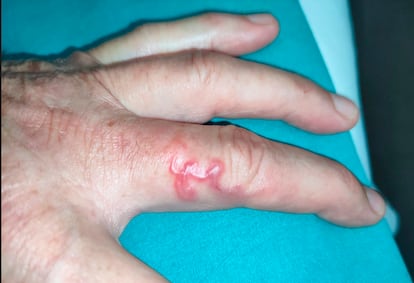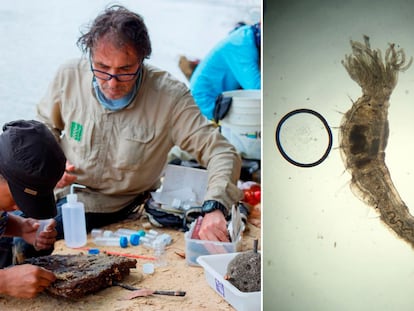Migratory larva: An intestinal parasite in dogs and cats that also goes under the skin of humans ‘by mistake’
Considered an exclusively tropical disease only a decade ago, it is now endemic in Spain after an increase in the number of diagnoses in patients who contracted the illness without traveling abroad

Parasites also make mistakes. Among larvae of Ancylostoma braziliense and Ancylostoma caninum, two species of nematodes that cause the disease known as cutaneous larva migrans, this occurs when they infect a person, mistakenly believing the individual to be a dog or cat. The larva needs to reach the digestive tract of these animals to complete its life cycle; thus, it can easily pass through all layers of canine and feline skin. In humans, however, it cannot go beyond the epidermis (the first layer of skin), under which it becomes trapped. There, seeking access to blood, it wanders around aimlessly, leaving a characteristic trail visible to the naked eye, until it dies without reaching the adult stage. In people, the infection is almost always mild, but without treatment it causes unbearable itching.
“Four days ago, I was bitten by a bug while working in the vegetable garden,” a 75-year-old retiree explained as he showed a small wound on the middle finger of his left hand to a doctor at the Dobra Health Center in Torrelavega (Cantabria), Spain. “When he arrived, the lesion was still poorly defined. It was easy to mistake it for a bite, a case of scabies or something else. So, we prescribed a corticosteroid cream and an antihistamine. After a few days, the parasite had moved and then the characteristic [marks] on the skin became visible,” explains Francisca Gómez Molleda, the family physician who treated the patient. The case will be presented at the Spanish Society of General and Family Physicians (SEMG) conference that begins on Wednesday in Granada.
Until a few years ago, this patient would have posed a major challenge for any physician. Larva migrans was considered a tropical disease, and if the person had not traveled outside Spain, the physician was unlikely to consider that he or she could suffer from it. All the specialists consulted admit that the situation has changed. “It may be because of climate change, the greater number of trips, the fact that doctors are more familiar with the disease, or a combination of all three. But it is clear that the number of diagnosed autochthonous cases has increased in recent years,” says Antonio Zurita, a professor in the Department of Microbiology and Parasitology at the University of Seville.
All cases of larva migrans originate in the small intestines of dogs and cats. Ancylostoma braziliense affects both animals while Ancylostoma caninum impacts only dogs (some other species of nematode can produce the disease, but it is very rare). There, adult specimens of the parasite, which measure between one and three centimeters, sexually reproduce.
“Infected animals expel thousands of eggs through their feces. If the soil is humid, shaded, has organic matter and a high temperature, a larva will form inside the egg, which can then develop until it measures 300 microns [there are 1,000 microns in a millimeter] and become infective,” Antonio Zurita notes.
If a dog or cat wanders around the area and steps or lies on this soil, the larva will continue its journey: it will burrow into the skin until it reaches the circulatory system and lungs and from there it will go through the respiratory tract to the upper respiratory tract. By swallowing, the animal itself will help the parasite reach the small intestine, where it will complete its development and give rise to a new cycle.
If a person does this, he or she will very likely end up with larva migrans. For this reason, experts consider the shady banks of rivers, lakes and beaches with fresh water in warm areas to be risky environments (direct sun and salt impede the development of larvae). Orchards and gardens pose a similar risk, which is why experts recommend not sitting or walking barefoot there and always wearing gloves, long clothing and boots when handling wet soil.
“It is important to keep in mind that infected dogs or cats must defecate in an area for it to pose a risk. That’s why the disease is much more common in socioeconomically less developed countries, where populations of these animals are less controlled,” experts say.
If all the dogs and cats living in Spain were regularly dewormed, the species that cause larva migrans would be eradicated in the country. Thus, specialists recommend having all pets dewormed first. “In Spain there aren’t usually any stray dogs, so the other major control measure should be taken with colonies of cats or specimens without owners,” explains Ana Pulido, the dermatologist who directs the skin infections clinic at the Gregorio Marañón Hospital in Madrid.
Pulido diagnosed the disease in a 59-year-old gardener from Madrid, in one of Spain’s first occupational cases, and published it in a scientific journal in 2019. “He was wearing boots and gloves, but unfortunately part of his ankle was exposed, and that’s where he got infected. The soil must have been very contaminated, most likely by cats,” she explains.
At the beginning of this century, only tropical medicine and travel medicine specialists studied the disease. The most significant work done in Spain was a series of 34 cases, all of which were imported and diagnosed between 1991 and 2002; now-retired researchers from the Tropical Medicine Unit at the Carlos III Hospital published these cases in 2004. “This disease is relatively common in travelers who have gone to hot and humid areas of the world,” explains Marta Díaz Menéndez, the head of the hospital’s Imported Pathology and International Health Unit. South America, Southeast Asia and Africa are, in that order, the areas from which most infected patients come.
It was not until the middle of the last decade that autochthonous cases of the disease started to appear in medical journals. “I remember a national dermatology conference seven or eight years ago in which we commented that we were beginning to see cases in people who had not left the country. From there, the [number of] published autochthonous cases grew,” explains Ana Pulido.
In 2016, a team at the University Hospital of Donostia (Gipuzkoa) published a series of four autochthonous cases. A year later, Altea Esteve, the head of the Pediatric Dermatology Section at the General Hospital of Valencia, published Spain’s only known case of a person who was infected twice. “It was a little girl who went to daycare. The first time, [the infection] was in the foot and the second time, five months later, [it was] in the trunk. Apparently, the source [of disease] was the sandbox at the daycare, which must have been contaminated by cats. It was also very hot that year,” the specialist says.
To date, medical journals have reported some 25 autochthonous cases diagnosed throughout Spain, although specialists agree that this likely underreports the number of infections. “Many cases are not published and there is a notable underdiagnosis, since, in its initial stages, larva migrans can be confused with other skin conditions,” says Antonio Zurita. Scabies is one of the diseases with which it has most commonly been confused in recent years; ivermectin is a possible treatment for both conditions.
Francisca Gómez Molleda chose this medication to treat the patient in Torrelavega. “There are other treatments for larva migrans, such as thiabendazole. But in recent years we—primary care physicians—have treated many cases of scabies and we have become accustomed to using ivermectin. It is a drug that doesn’t have many side effects, and we can identify it quickly, so it is a safe and effective therapeutic option,” she concludes.
Sign up for our weekly newsletter to get more English-language news coverage from EL PAÍS USA Edition
Tu suscripción se está usando en otro dispositivo
¿Quieres añadir otro usuario a tu suscripción?
Si continúas leyendo en este dispositivo, no se podrá leer en el otro.
FlechaTu suscripción se está usando en otro dispositivo y solo puedes acceder a EL PAÍS desde un dispositivo a la vez.
Si quieres compartir tu cuenta, cambia tu suscripción a la modalidad Premium, así podrás añadir otro usuario. Cada uno accederá con su propia cuenta de email, lo que os permitirá personalizar vuestra experiencia en EL PAÍS.
¿Tienes una suscripción de empresa? Accede aquí para contratar más cuentas.
En el caso de no saber quién está usando tu cuenta, te recomendamos cambiar tu contraseña aquí.
Si decides continuar compartiendo tu cuenta, este mensaje se mostrará en tu dispositivo y en el de la otra persona que está usando tu cuenta de forma indefinida, afectando a tu experiencia de lectura. Puedes consultar aquí los términos y condiciones de la suscripción digital.
More information
Últimas noticias
Welcome to the post-religion era: The idea of Christianity as the absolute truth has become obsolete
‘I thought you would like it’: The risky sexual practice popularized by TV shows and TikTok
The digitalization of tourism: ‘They promise experiences and gave us the worst possible one’
Mexican peso defies uncertainty with forecasts of a new period of stability in 2026
Most viewed
- Sinaloa Cartel war is taking its toll on Los Chapitos
- Reinhard Genzel, Nobel laureate in physics: ‘One-minute videos will never give you the truth’
- Oona Chaplin: ‘I told James Cameron that I was living in a treehouse and starting a permaculture project with a friend’
- Why the price of coffee has skyrocketed: from Brazilian plantations to specialty coffee houses
- Silver prices are going crazy: This is what’s fueling the rally











































